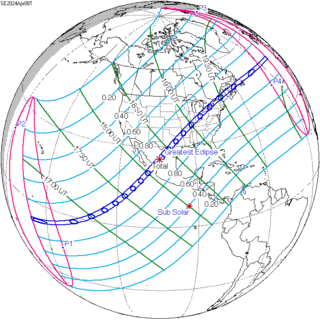Solar eclipse of April 8, 2024
| Solar eclipse of April 8, 2024 | |
|---|---|
| Type of eclipse | |
| Nature | Total |
| Gamma | 0.3431 |
| Magnitude | 1.0566 |
| Maximum eclipse | |
| Duration | 268 sec (4 m 28 s) |
| Location | Nazas, Durango, Mexico |
| Coordinates | 25°18′N 104°06′W / 25.3°N 104.1°W |
| Max. width of band | 198 km (123 mi) |
| Times (UTC) | |
| (P1) Partial begin | 15:42:07 |
| (U1) Total begin | 16:38:44 |
| Greatest eclipse | 18:18:29 |
| (U4) Total end | 19:55:29 |
| (P4) Partial end | 20:52:14 |
| References | |
| Saros | 139 (30 of 71) |
| Catalog # (SE5000) | 9561 |
A total solar eclipse will take place on April 8, 2024, visible across North America and Central America. A solar eclipse occurs when the Moon passes between Earth and the Sun, thereby totally or partly obscuring the image of the Sun for a viewer on Earth. A total solar eclipse occurs when the Moon's apparent diameter is larger than the Sun's, blocking all direct sunlight, turning day into darkness. Totality occurs in a narrow path across Earth's surface, with the partial solar eclipse visible over a surrounding region thousands of kilometres wide. With a magnitude of 1.0566, its longest duration of totality will be of four minutes and 28 seconds near the town of Nazas, Durango, Mexico, and the nearby city of Torreón, Coahuila.
Totality will be visible in a narrow strip of land in North America, beginning at the Pacific coast, then crossing northern Mexico through the states of Sinaloa, Durango and Coahuila, in the United States, through the states of Texas, Arkansas, Missouri, Illinois, Kentucky, Indiana, Ohio, New York, and Vermont, and finally the southern parts of the provinces Ontario, Quebec and New Brunswick, western Prince Edward Island, and the island of Newfoundland in eastern Canada. Then, it will vanish at the eastern Atlantic Coast of Newfoundland. It will be the 2nd total eclipse visible from the central United States in just 7 years, coming after the August 21, 2017 eclipse.
...
Wikipedia

